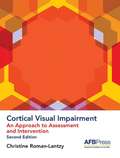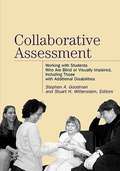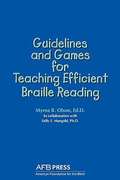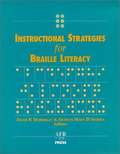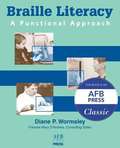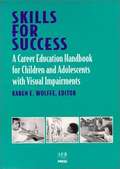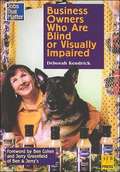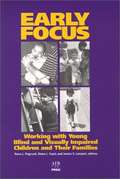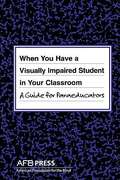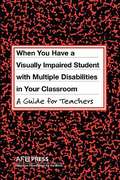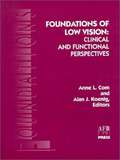Special Collections
American Foundation for the Blind
Description: American Foundation for the BlindPress offers a wide range of information for students, professionals, researchers, and blind and visually impaired people and their families. #teachers #disability
- Table View
- List View
Cortical Visual Impairment
by Christine Roman-LantzyCortical Visual Impairment: An Approach to Assessment and Intervention provides educators, therapists, physicians, and parents of children with CVI with an understanding of the condition and a complete framework for assessment and intervention. The new and revised content in this second edition brings the book up-to-date with new research and insights into CVI, its development and progression, and the best approaches to assessment and intervention with children affected by this condition. As in the previous edition, assessment forms, including the CVI Range and CVI Progress Chart, provide a comprehensive method for evaluating the functional vision status of, and program planning for, children with CVI.
Report on Needs Assessment Methodology
by Anne Marie Delaney and Ronald L. NuttallThe major purpose of this report is to assist others who plan to conduct their own needs assessment for a blind population or for another special needs population.
Collaborative Assessment
by Stephen A. Goodman and Stuart H. WittensteinThis comprehensive text published by AFB in 2003 is the first to present assessment in a way that can be understood by professionals and families alike.
Perceptual Factors in Braille Word Recognition
by Carson Y. Nolan and Cleves J. KederisThis monograph presents the findings of several years of study of the braille system as a communication process.
A Celebration of Solutions
by Karen E. WolffeAlthough there has been an ever-increasing awareness of the critical need for literacy skills in the United States (Chisman, 1990; Graubard, 1991; Sum, 1999), very little attention has been focused on the special challenges inherent in providing basic literacy skills instruction to adults with visual disabilities.
Guidelines and Games for Teaching Efficient Braille Reading
by Myrna R. Olson and Sally S. MangoldThese unique guidelines and games provide ideas for adapting a general reading program to the needs of braille readers and enriching early instruction in braille that are based on research in the areas of rapid reading and precision teaching. Classroom teachers and anyone working with children who are blind or visually impaired will find this classic handbook an invaluable resource.
Instructional Strategies for Braille Literacy
by Diane P. Wormsley and Frances M. D'AndreaOffers instructors specific, practical strategies for the teaching of Braille reading and writing. Chapters discuss general guidelines and strategies; fostering emergent learning; making the transition from print to Brail teaching Braille to students with special needs, and to students who speak English as a second langua assessing the literary skills of students who are blind or visually impaired; and technology and Braille. Annotation copyrighted by Book News, Inc. , Portland, OR
Braille Literacy
by Diane P. WormsleyWormsley (program director, Professional Preparation Program in Education of Children with Visual and Multiple Disabilities, Pennsylvania College of Optometry) describes an approach to braille reading and writing instruction based on students' individual interests, needs, and goals. She offers general guidelines for a functional approach to braille literacy, then offers case studies of how the program can be modified for at-risk learners. The approach works with children and adults learning braille for the first time. B&w photos of instructional materials are included. Annotation ©2004 Book News, Inc., Portland, OR (booknews.com)
The Future of Work for Disabled People
by Ian Morris and Wassily Leontief and Walter Y. Oi and William F. Gallagher and Curt Tausky and Timm Kainen and Lawrence A. Scadden and William J. Dennis and Dennis Chamot and Jesse M. Smith and Erich Bloch and Joseph F. CoatesThis important book, by an impressive and talented team of authors, will help us plan to ensure that workers with disabilities find their rightful place in the workplace of the future.
Looking at Employment Through a Lifespan Telescope
by Corinne Kirchner and Emilie Schmeidler and Alexander TodorovThis book gathers representative survey data from the legally blind population on employment issues, and analyzes it using a lifespan perspective (considering age, career stage, and age-at-onset of visual impairment), which is critical to understanding widely different employment issues for subgroups of the blind and visually impaired population.
Skills for Success
by Karen E. WolffeInnovative materials for helping youngsters start on successful careers! Skills for Success details specific activities for preparing children with visual impairments for independence in daily life and success on the job. This comprehensive manual outlines how important capabilities can be developed through meaningful learning experiences at different ages. Contributors who are experts in their subject areas focus on suggestions for developing abilities leading to career and life satisfaction for preschoolers, elementary school students, and middle school students. Providing a wide range of information and resources, Skills for Success will prove an invaluable guide to teachers, parents, and others who work with children with visual impairments.
Business Owners Who Are Blind or Visually Impaired
by Deborah KendrickThe second title in the exciting Jobs That Matter series written by an award-winning blind journalist, Business Owners Who Are Blind or Visually Impaired demonstrates the wide range of careers and talents that can be pursued by persons with visual impairments. Each profile features a successful individual who has accomplished his or her dream of business ownership and who shares important insights. From a lawyer and an accountant to a florist and a gourmet cook, the range of engaging stories told will inspire young adults with visual impairments and the parents, teachers, and counselors who advise them.
Competency Based Curriculum for Teachers of the Visually Handicapped
by Susan J. SpunginThis book is a guideline for teachers of the blind. Six basic types of education system now exist, and were examined for the purposes of this study: full-time special class, resource room, itinerant program, resource room/itinerant program, teacher consultant, and residential school.
Program Planning and Evaluation for Blind and Visually Impaired Students
by Jack Hazekamp and Kathleen Mary HuebnerThe guidelines have been developed as a resource for parents, staff, and administrators in identifying and assessing the unique needs of visually impaired students and planning, providing, evaluating, and improving the quality and cost-effectiveness of programs serving these students.
Early Focus
by Jessica S. Lambert and Diane L. Fazzi and Rona L. PogrundStressing the importance of early intervention in working with children with visual impairment, Pogrund (formerly special education, California State U.) and Fazzi (special education, California State U.) offer practitioners (teachers and other specialized professionals) an edited guide to working with children under age five. Eleven chapters review the developmental areas that are likely to be affected by vision loss and discuss the theory and knowledge base behind suggested educational practices in these areas. Chapters cover working with families, medical and functional implications, cognitive development, literacy, social development, promotion of independence and daily living skills, behavioral supports, motor and mobility development, and working with other professionals. Annotation (c)2003 Book News, Inc., Portland, OR (booknews.com)
No Time to Lose
by Pauline M. MoorMultiply impaired blind children present special educational problems and as their number increases, their educational needs are of increasing concern, because many of them arrive at school severely retarded in their development. Several years ago the American Foundation for the Blind called a seminar to discuss teaching procedures then being used, as well as ideas for new techniques. The participants came from the field of special education; most were classroom teachers who had extensive experience with multiply impaired blind children. This report is an outgrowth of that meeting.
When You Have a Visually Impaired Student in Your Classroom
by Joanne Russotti and Rona Shaw and Susan Jay SpunginThis guide defines the paraeducator's role and how they work with other education team members. Subjects covered in the book include basics of visual impairment, tips for encouraging student growth and the special material and devices needed by the student. Forms are also included to help organize information and track progress.
When You Have a Student with Visual and Multiple Disabilities in Your Classroom
by Jane N. Erin and Susan J. SpunginAs a special educator, a classroom teacher, or an educational team member, you may be working with a visually impaired student for the first time or as an experienced professional. This booklet provides information on how visual impairment affects learning in communication, movement, self-care skills, and other important areas, and on how to work effectively with students who have visual and other disabilities.
Toward Independence
by Anne YeadonThis book is an introduction to the use of instructional objectives in the teaching of severely visually impaired persons. While it happens to use a daily living skills course as an example of how a teacher might develop a course around this educational method, it is not a daily living skills teaching manual. A creative teacher should be able to adapt the approach as described in Toward Independence to many other subjects.
Foundations of Low Vision
by Alan J. Koenig and Anne L. CornThis text explains in great detail how to do low vision exams, the principles behind magnifiers and other forms of magnification, and much more.
What Museum Guides Need to Know
by Gerda Groff and Laura GardnerThis book provides practical, easy-to-use suggestions on how to greet and assist blind and visually impaired visitors. It also covers aesthetics and visual impairment, legal requirements for accessibility, and resources. It includes a training outline for museum professionals, a bibliography on art and museum access for blind and visually impaired persons, and guidelines for preparing large print, braille, and cassette materials.
Data on Blindness and Visual Impairment in the U. S.
by Corinne KirchnerData from a wide variety of sources cover age, gender, race and ethnicity, education, employment and income, service delivery systems, vision services, employment-related services, and income benefits program.
Living with Impaired Vision
by Anne Yeadon and Dava GraysonBlind and visually impaired people: active, concerned about their jobs, their families, their communities, obtaining a good education, discovering interesting ways to use their leisure time, and above all, as different from one another as any other group of people who happen to have one characteristic in common. Today there are visually impaired people in every major area of employment from professional occupations to technical and clerical work. There are blind lawyers and college professors and insurance salesmen and social workers, blind typists and switchboard operators, auto mechanics and chemical engineers.
Travel in Adverse Weather Conditions
by Richard L. Welsh and William WienerThis report marks the first attempt to pull together the knowledge of a large number of people related to the problem of travel in adverse weather for people who have visual impairments. These ideas represent the state of the art as defined by a wide sample of practitioners from all over the United States who participated in the National Conference on Travel in Adverse Weather in Minneapolis in February, 1975.
The Demography and Causes of Blindness
by Hyman GoldsteinA report on the statistics of blindness from an international point of view.
